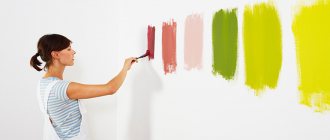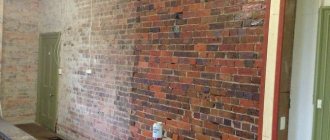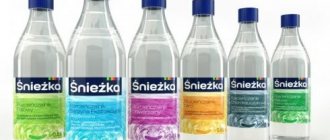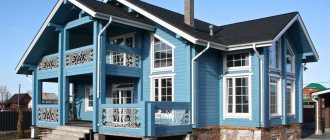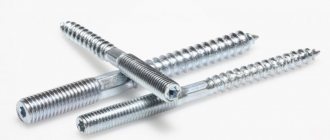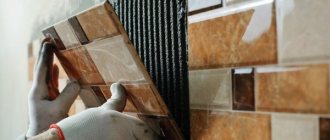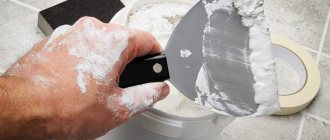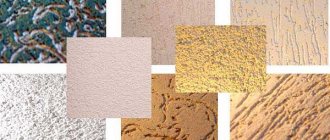There is no such repair that could be done without the use of paints and varnishes. With the start of renovation work, numerous odors enter the house, among which fumes from drying paint are clearly not the most pleasant. Most of us would prefer not to inhale dangerous fumes, but rather use safer materials whenever possible. If you set a goal, you can find a suitable option, for example, to have floor paint that is odorless and quick-drying.
Options
Many users are interested in how to choose odorless paint and whether it even exists. There are certain types of paint with a neutral or minimal odor. Such options will not adversely affect a person’s health and will not cause irritation of the mucous membrane.
So, these types of odorless paints are distinguished.
Acrylic type
This is one of the most popular options. The paint is made on a water basis, so there is no harm to human health or well-being.
This option is actively used both for domestic purposes and in construction. There is no aroma inherent in other varieties as such. The paint dries quickly and consists of safe ingredients.
This type of paint has high moisture resistance and is easy to use for various types of surfaces. For example, this odorless paint is suitable for treating batteries. Concrete or wooden surfaces are not prohibited in this case.
Thanks to the variety of shades, you can choose the most optimal option. The cost is quite high, but the quality characteristics of the product justify such expenses.
Features of water-based wall paints: how much the compositions cost, their types
Water-based dyes have a liquid consistency. Due to this, the protective coating is reliable, because the composition is able to penetrate deep into the wood. The mixture is based on water, coloring pigments and binders. In addition, the composition contains fillers that ensure quick drying of the paint, moisture resistance of the coating, etc.
The composition and consistency of water-based wall paint can be adjusted for ease of application using water
To dilute the dye, an organic-based solvent is used. White Spirit is optimal for these purposes. The coating dries 2-6 hours after application. There are several types of emulsions on sale, so it is recommended to carefully study the information on the packaging.
Water-dispersion type
Its structure resembles the previous type. This is a great option for painting walls. For ceiling treatment, this option is considered the most optimal. The paint is based on special particles that are completely safe for human health.
The positive thing is that there is no specific smell, the paint dries quite quickly. On the surface, the painting looks quite attractive and can complement any stylistic decision.
It is also worth noting the water-repellent properties. Thanks to this, the painted surface can be washed without fear of damage.
How to determine color
Before choosing a color for your kitchen decor, you need to think about what the room should be positioned with. You need to cheer up, cheer up, create a good appetite. Only positive emotions will allow you to properly tune in to the difficult day ahead.
The predominance of red tones increases appetite and blood pressure. If you stay in such a room for a long time, you may feel uncomfortable. You need to be extremely careful with this color. Use in small quantities.
Orange tones lift your spirits in the morning. But in excessive quantities they irritate the optic nerves.
Yellow color calms the nervous system.
It is better to avoid dark green, purple, and gray tones in the kitchen. They reduce appetite.
You can paint several colors at once. They are grouped according to their combination and positive effect on a person. Different colors will allow you to correctly zone the space. The color of the walls should be in harmony with the kitchen set.
Oil type
The composition of this type is complex, but differs in its quality characteristics. Today there is a huge selection of such paints.
During application, it is worth remembering the optimal temperature - up to 7 degrees Celsius. In this case, drying will occur much faster.
This odorless paint is perfect for flooring. A huge advantage is the absence of a specific smell. There are colored and colorless paints.
This type of paint is also actively used for wood. This is a universal option that is suitable for interior and exterior decoration.
Even if there is a decorative design on the wooden surface, for example, patterns or drawings, inscriptions, this type can be used.
Varieties of odorless paints
Harmless paints are classified according to the base from which they are made:
- acrylic;
- oil;
- latex;
- water-dispersed.
Note! There are also alkyd compositions with a weak odor. However, they cannot be called harmless, since an organic solvent is used in their production.
Each of the listed types of paints has its own characteristics, which we will consider below.
Oily
Oil-based compositions are distinguished by the absence of pungent odors. Oil-based paints and varnishes are a mixture of drying oil and pigmenting substances. Drying oil acts as a thinner.
Oil-based coatings can be colored or colorless. They are used for both interior and facade work. Oil paints are used on a wide variety of materials, including metal, wood, concrete and even plaster. Often such compositions are used for artistic decoration of surfaces (drawings, inscriptions, patterns).
Oil formulations are relatively inexpensive and are available to a wide range of consumers. A significant disadvantage of oil-based coatings is that they take quite a long time to dry.
Water-dispersed
The solvent of dispersion particles is water. Therefore, such paints are considered safe. Water-dispersed odorless floor paint is always white. It has no unpleasant odor, is a quick-drying composition and has excellent decorative characteristics. Water-dispersed coatings are water-resistant, and therefore surfaces painted with this composition can be washed without fear of damaging them. Since paints of this type are harmless, they can be used when painting children's rooms, rooms in hospitals and schools.
Water-dispersion paints do not differ in color variety - they are usually white. However, with the help of colors the composition can be given the desired shade.
Water-dispersed coatings do not pose a danger to human skin. If necessary, such paint can be washed off with plain water, without the use of toxic solvents.
Note! Water-dispersion compositions have restrictions on their use: they are not recommended for painting heating appliances, wood and metal products. In the latter case, it is recommended to use odorless oil paint for metal.
Latex
Odorless latex enamel is not classified as toxic paints and materials, and therefore has no unpleasant odor. This enamel is often used when painting interior spaces; it can be applied to various types of surfaces, including plaster, brick and even wallpaper.
Latex compounds are characterized by high strength and wear resistance. Due to the presence of latex, the enamel is not prone to drying out and swelling. Odorless latex bathroom paints are moisture resistant. This enamel can also be used for painting kitchen areas.
Latex enamel dries quickly: 20-30 minutes are enough for the surface to dry initially. Final drying occurs within an hour.
Acrylic
Odorless acrylate-based paint is by far the most common option for painting household surfaces. They can be used to paint almost all types of materials. Like oil paints, acrylic paints and varnishes are often used for artistic surface decoration.
Acrylic paints have many advantages:
- complete absence of odors, since they contain no toxins;
- health safety for builders and residents;
- fire safety;
- maximum versatility of application;
- ease of application (you can use both standard tools and a textured roller to create the desired relief);
- high level of adhesive properties;
- wide color range;
- various textures (including the possibility of creating smooth and matte coatings);
- non-cracking coating;
- quick drying;
- good hiding power (both with and without primer);
- resistance to abrasive loads;
- resistance to negative environmental influences (humidity, ultraviolet radiation, temperature changes).
The disadvantage of acrylic paints and varnishes is their relatively high cost. However, due to the high performance properties, this drawback can be considered insignificant.
As a result of painting with polyacrylates, the surface becomes white. To give the coating a different color, you need to purchase a color scheme of the desired tonality. Color is added to acrylic paint in the proportion specified by the manufacturer.
Some construction supermarkets offer consumers the service of selecting the desired color using a computer. The buyer only needs to indicate the paint color he likes in the catalog and inform the operator of the corresponding product number. After this, the selected product of the desired color in a sealed package is delivered to the checkout.
Acrylic paints and varnishes can be equipped with special additives with antiseptic properties even during production. Such additions help prevent the occurrence of fungus and mold. Antiseptics are especially relevant for painted wooden surfaces in wet areas.
Water-repellent and dirt-repellent substances are added to some types of paints. Surfaces coated with such paints and varnishes do not require frequent cleaning. In addition, the coating gains additional resistance to moisture.
Finishing
Each surface will need a specific type of paint. To avoid mistakes, you should consult with a specialist in advance.
They offer painting for walls, floors, windows and restoration of heating radiators.
The surface differs in structure and operating conditions. We are talking about elevated temperature and humidity.
conclusions
The best solution is to use odorless paints. They dry quickly enough and are easy to care for in the future.
The best aerosol paint in cans - main types, application features and advantages of useThe best water-based paint - ranking of the best manufacturers of 2018
How to choose façade paint for exterior use - a review of popular manufacturers and a rating of the best paints for exterior use
It is necessary to prepare the surface, then the materials for the work process. By preparing for work, taking into account the recommendations of specialists, you will make the right choice.
